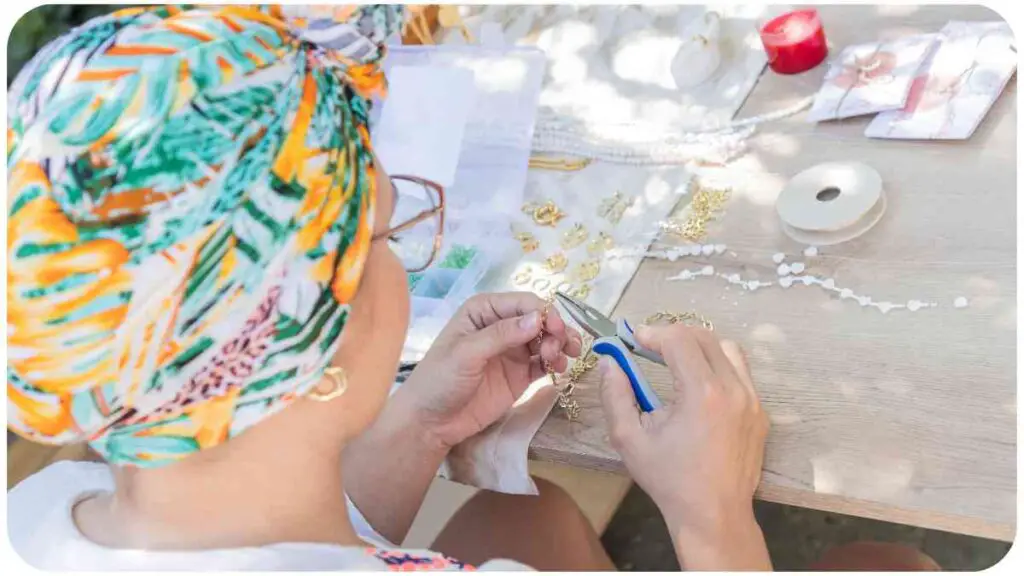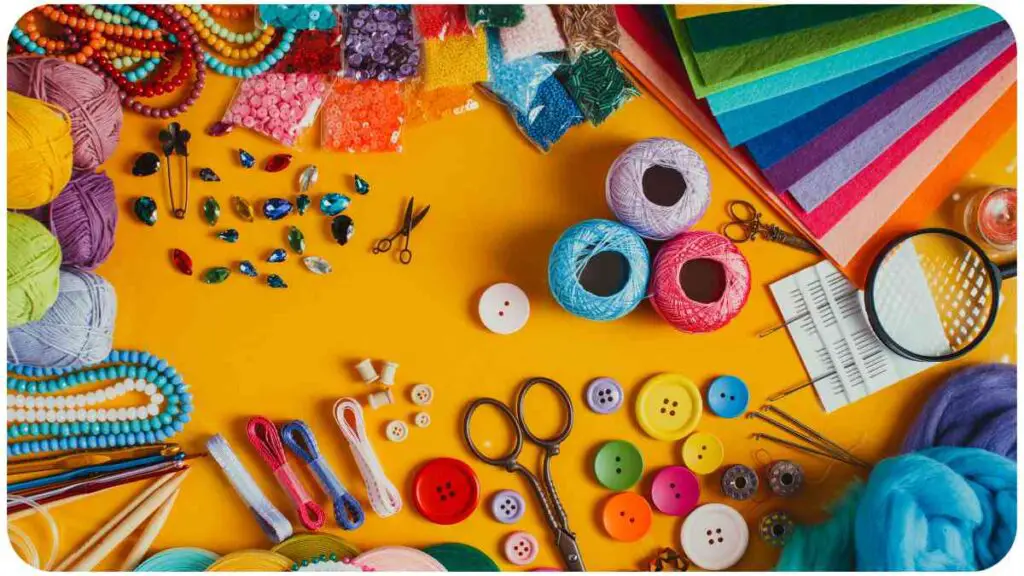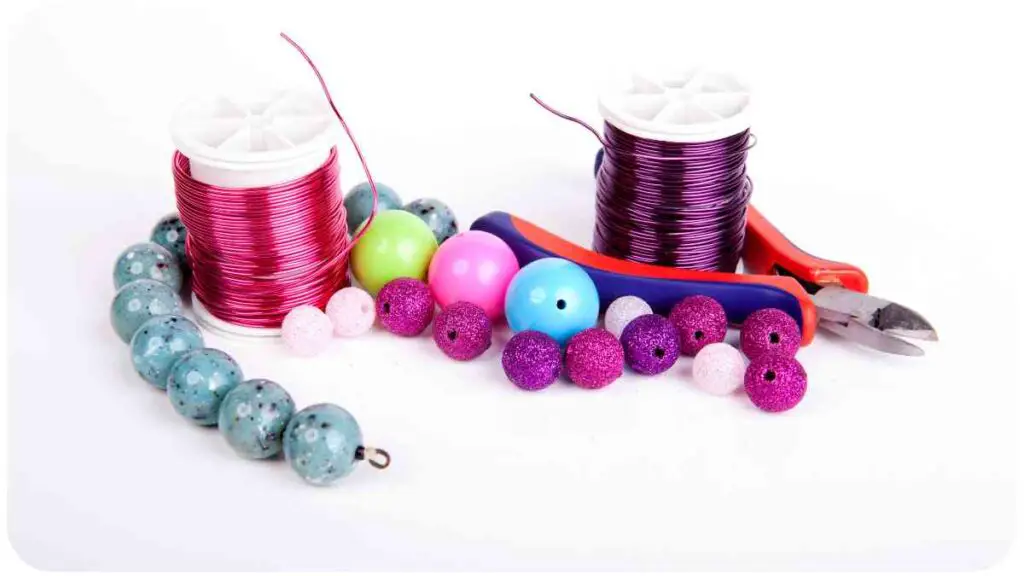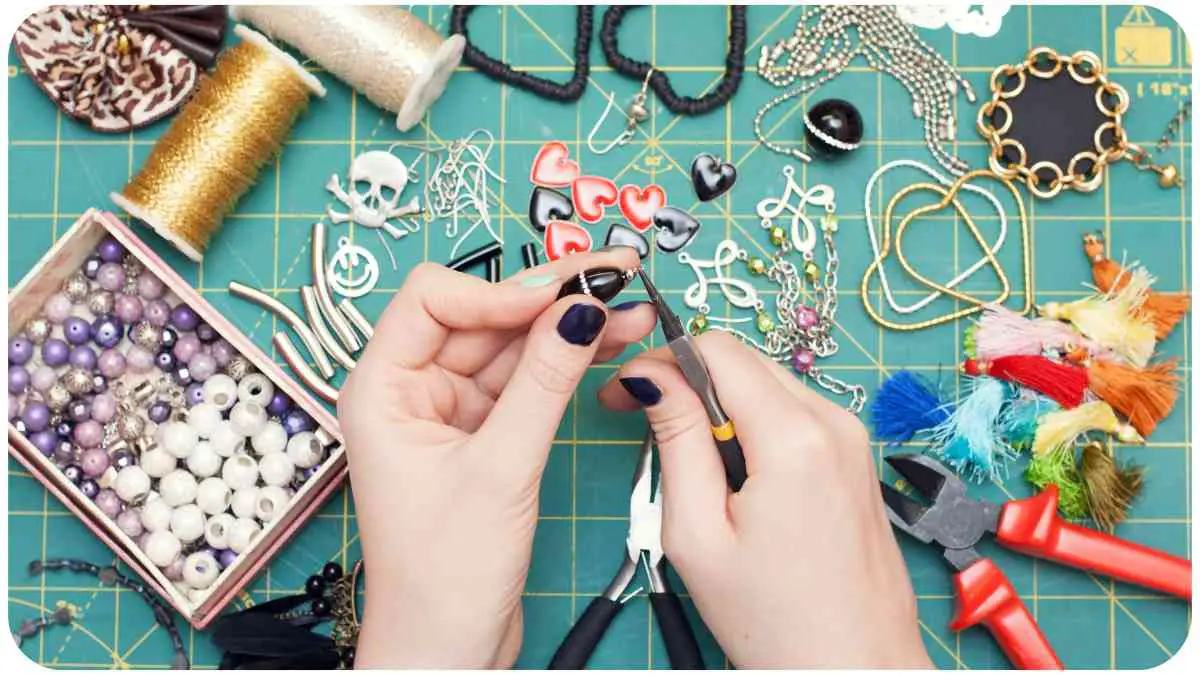Welcome to the realm of crafting and jewelry making, where the choice of materials can make or break your masterpiece. In this guide, we’ll delve into the versatile world of 16 gauge wire and explore its myriad uses, benefits, and tips for working with this indispensable crafting companion.
| Takeaways |
|---|
| 16 gauge wire offers a balance of durability and flexibility, making it versatile for various crafting projects. |
| Its compatibility with different materials, availability in various finishes, and suitability for jewelry and sculptures make it a popular choice. |
| Essential tools for working with 16 gauge wire include wire cutters, round-nose pliers, flat-nose pliers, and nylon jaw pliers. |
| Choosing the right material, finish, color, and wire shape is crucial for successful crafting with 16 gauge wire. |
| Explore diverse sources for 16 gauge wire, such as craft stores, online retailers, and specialty jewelry suppliers, to find quality options. |
| Expert recommendations highlight the importance of experimenting with materials and finishes to discover unique qualities in designs. |
| Overcome challenges by practicing patience, seeking guidance, and maintaining proper connections for wire sculptures. |
| Consider the weight, intricacy, and wearer’s comfort when selecting the gauge, comparing 16 gauge wire with other options like 18, 14, and 20 gauges. |
| Industry insights from experts, success stories, and innovators provide inspiration for pushing creative boundaries with 16 gauge wire. |
| Frequently Asked Questions (FAQs) cover topics such as the uses of 16 gauge wire, its suitability for delicate jewelry, maintenance tips for wire sculptures, where to purchase quality wire, and essential tools for working with it. |
2. Understanding 16 Gauge Wire
Before we dive into its applications, let’s demystify what 16 gauge wire is and why it holds a special place in the hearts of crafters and jewelry enthusiasts.
Unlock the secrets of wire wrapping with our comprehensive tutorial. Discover essential techniques, tips, and creative ideas to master wire wrapping and elevate your jewelry crafting skills.
Table 1: Key Characteristics of 16 Gauge Wire
| Characteristic | Description |
|---|---|
| Gauge | 16 |
| Diameter | 0.0508 inches (1.291 mm) |
| Material | Varies (steel, copper) |
| Flexibility | High |
| Common Uses | Jewelry, sculptures, DIY |
Stay tuned as we explore the benefits and popular uses of this remarkable wire in the sections that follow.
3. Benefits of Using 16 Gauge Wire
Crafting and jewelry making are intricate arts that demand precision and reliability from materials. Let’s uncover why 16 gauge wire stands out as a preferred choice among artisans.
3.1 Durability
When it comes to crafting durable and long-lasting pieces, 16 gauge wire takes the spotlight. Its thicker diameter provides robustness, making it resistant to bending or breaking. Whether you’re creating a statement necklace or a wire sculpture, durability is a crucial factor, and 16 gauge wire delivers.
3.2 Flexibility
Despite its sturdiness, 16 gauge wire doesn’t compromise on flexibility. This characteristic allows artisans to bend and shape the wire with relative ease, facilitating intricate designs without sacrificing structural integrity. The balance between durability and flexibility makes it an ideal choice for various crafting endeavors.
Dive into the world of DIY jewelry with our collection of 10 easy projects designed for beginners. From simple earrings to intricate bracelets, explore these creative ideas and start crafting beautiful accessories today.
Table 2: Comparing Durability and Flexibility
| Characteristic | 16 Gauge Wire | 18 Gauge Wire | 14 Gauge Wire |
|---|---|---|---|
| Durability | High | Moderate | Very High |
| Flexibility | High | High | Moderate |
| Common Uses | Jewelry, Sculptures | Delicate Jewelry, Wire Wrapping | Robust Jewelry, Sculptures |
In the world of crafting, finding materials that strike the right balance between durability and flexibility is essential. 16 gauge wire emerges as a reliable companion for artists seeking both traits in their creations.
3.3 Compatibility
Versatility is a hallmark of 16 gauge wire, making it compatible with a wide range of beads, stones, and other jewelry components. Whether you’re working on a chunky bracelet or a delicate pair of earrings, this wire adapts seamlessly, allowing for diverse and creative designs.
3.4 Availability
Availability is a key consideration for crafters, and 16 gauge wire doesn’t disappoint. It’s readily accessible in various materials, including steel and copper, providing artists with options to suit their preferences and project requirements.
Unleash your creativity and make truly unique handmade jewelry. Our guide offers insights into design principles, color combinations, and creative techniques to help you express your personal style through stunning jewelry pieces.
Crafting with 16 gauge wire not only guarantees durability and flexibility but also opens up a world of creative possibilities. In the next section, we’ll explore some of the popular uses of 16 gauge wire in jewelry making.
4. Popular Uses in Jewelry Making

Crafting stunning jewelry requires a keen understanding of materials and techniques. Let’s explore how 16 gauge wire elevates the art of jewelry making with its versatility and adaptability.
4.1 Necklaces
Creating statement necklaces becomes a breeze with 16 gauge wire. Its durability supports the weight of various beads and pendants, while its flexibility allows for intricate designs. Whether you opt for a minimalist or bold aesthetic, 16 gauge wire provides a sturdy foundation for your necklace creations.
Table 3: Ideal Uses for 16 Gauge Wire in Jewelry
| Jewelry Type | Ideal Gauge | Recommended Materials |
|---|---|---|
| Necklaces | 16 Gauge | Gemstones, beads, pendants |
| Bracelets | 16 Gauge | Charms, crystals, seed beads |
| Earrings | 18 Gauge | Dangles, hoops, studs |
| Wire Wrapping | 20 Gauge | Cabochons, focal beads |
4.2 Bracelets
Whether you’re crafting a dainty charm bracelet or a bold cuff, 16 gauge wire provides the structural integrity needed for wrist adornments. Its compatibility with various beads and charms allows for endless design possibilities, catering to diverse tastes and styles.
Elevate your beading projects with the best supplies available. Explore our comprehensive guide to discover the essential beading supplies that every crafter needs, ensuring your creations are not only beautiful but also durable.
4.3 Earrings
While 16 gauge wire might be a bit too thick for delicate earring designs, it can still play a crucial role in creating statement earrings. Combining it with thinner gauges for intricate details or using it as a base for larger, more substantial earrings showcases its versatility in the realm of ear adornments.
4.4 Wire Wrapping Techniques
Wire wrapping is an art in itself, and 16 gauge wire serves as an excellent choice for creating robust frames for stones and cabochons. Its thickness provides stability, ensuring that the wrapped elements remain securely in place. As we continue, we’ll explore how this wire goes beyond jewelry making, venturing into the broader world of crafting.
5. Crafting Marvels with 16 Gauge Wire

Jewelry making is just the tip of the iceberg when it comes to the capabilities of 16 gauge wire. Let’s uncover how this versatile material extends its influence into various crafting realms.
5.1 Sculptures
The thickness and flexibility of 16 gauge wire make it a favorite among sculpture artists. Whether you’re sculpting intricate figurines or abstract pieces, the wire provides a strong yet malleable structure. As an artist, I’ve personally experienced the satisfaction of bringing wire sculptures to life using 16 gauge wire as the backbone.
Create a stylish beaded bracelet effortlessly with our step-by-step guide. Follow our detailed instructions and learn how to make a beaded bracelet in just 15 simple steps, showcasing your craftsmanship in a beautiful accessory.
Table 4: Crafting Possibilities with 16 Gauge Wire
| Crafting Type | Ideal Gauge | Recommended Materials |
|---|---|---|
| Sculptures | 16 Gauge | Steel, copper, aluminum |
| Home Decor | 14 Gauge | Wire frames, wall art |
| DIY Projects | 18 Gauge | Wire accents, plant hangers |
| Garden Art | 16 Gauge | Outdoor sculptures, plant stakes |
5.2 Home Decor
Elevate your home decor with the use of 16 gauge wire. Its sturdiness allows for crafting wire frames for wall art, geometric sculptures, and other decorative elements. The possibilities are endless, limited only by your imagination.
5.3 DIY Projects
Engage in DIY projects with confidence, knowing that 16 gauge wire can handle a variety of tasks. From creating wire accents for furniture to crafting stylish plant hangers, this wire proves its adaptability beyond the traditional realms of crafting.
5.4 Garden Art
Take your creativity outdoors by incorporating 16 gauge wire into garden art projects. Craft plant stakes, outdoor sculptures, and decorative elements that withstand the elements while adding a touch of artistic flair to your garden.
In the next section, we’ll delve into valuable tips for working with 16 gauge wire, ensuring that your crafting journey is not only creative but also seamless and enjoyable.
6. Tips for Working with 16 Gauge Wire
Crafting with 16 gauge wire requires a combination of skill and practical know-how. Let’s explore essential tips that will enhance your experience and ensure successful outcomes in your projects.
6.1 Tools of the Trade
Investing in quality tools is paramount when working with 16 gauge wire. Ensure you have a sturdy pair of wire cutters, round-nose pliers, and flat-nose pliers. These tools will assist you in shaping and manipulating the wire with precision.
Table 5: Essential Tools for Working with 16 Gauge Wire
| Tool | Purpose |
|---|---|
| Wire Cutters | Cutting the wire to desired lengths |
| Round-Nose Pliers | Creating loops and curves |
| Flat-Nose Pliers | Gripping and shaping the wire |
| Nylon Jaw Pliers | Preventing scratches on the wire |
6.2 Safety Measures
Crafting should be an enjoyable and safe experience. When working with 16 gauge wire, it’s essential to take certain safety precautions. Wear protective eyewear to shield your eyes from any stray wire ends, and consider using gloves to protect your hands, especially if you’re working on projects that involve repetitive motions.
6.3 Maintenance
Proper maintenance of your tools and workspace contributes to the longevity of both your equipment and your crafted pieces. Regularly clean your pliers to remove any residue that may accumulate during use. Store your 16 gauge wire in a cool, dry place to prevent it from corroding or becoming damaged.
6.4 Troubleshooting
Encountering challenges during your crafting journey is inevitable, but understanding how to troubleshoot common issues can save you time and frustration. If you find the wire difficult to manipulate, consider using a nylon jaw plier to avoid scratching the surface. Experiment with different techniques to achieve the desired results.
As we navigate the world of 16 gauge wire, it’s crucial to understand the factors that influence its selection. In the next section, we’ll explore how to choose the right 16 gauge wire for your specific projects.
7. Choosing the Right 16 Gauge Wire

The success of your crafting endeavors hinges on selecting the appropriate materials. Let’s unravel the considerations for choosing the right 16 gauge wire for your projects.
7.1 Material Options
16 gauge wire is available in various materials, each offering unique characteristics. Steel and copper are common choices, with steel providing additional strength and copper adding a warm, distinctive color to your creations. Consider the aesthetic and properties you desire for your project when selecting the material.
7.2 Finish Varieties
The finish of the wire contributes significantly to the final look of your crafted pieces. Whether you prefer a polished, matte, or antiqued finish, 16 gauge wire comes in a variety of options to suit your artistic vision. Experiment with different finishes to find the one that complements your style.
Table 6: Material and Finish Options for 16 Gauge Wire
| Material | Characteristics | Finish Options |
|---|---|---|
| Steel | High strength, durability | Polished, matte, coated |
| Copper | Warm color, malleability | Antiqued, oxidized, bare |
| Aluminum | Lightweight, corrosion-resistant | Anodized, colored |
7.3 Color Selection
Color plays a crucial role in the visual appeal of your creations. While some artisans appreciate the natural patina of copper, others may prefer the sleek look of coated steel. Consider the color palette of your project and choose a wire color that complements or contrasts effectively.
7.4 Wire Shapes
Beyond the standard round wire, 16 gauge wire is available in various shapes, including square and half-round. These shapes add an extra dimension to your designs, allowing for innovative and unique creations. Experiment with different wire shapes to discover new possibilities.
In the following section, we’ll compare 16 gauge wire with other gauges commonly used in crafting to provide a comprehensive understanding of its place in the crafting landscape.
8. Comparison with Other Gauges
Choosing the right gauge for your project is crucial, and understanding how 16 gauge wire compares to other commonly used gauges can guide your decision-making process.
8.1 18 Gauge Wire
While 18 gauge wire is thinner than 16 gauge, it offers greater flexibility. It’s ideal for delicate jewelry designs and intricate wire wrapping. Consider the level of detail and the intended use of your project when deciding between 16 and 18 gauge wire.
Table 7: Comparing 16 Gauge and 18 Gauge Wire
| Characteristic | 16 Gauge Wire | 18 Gauge Wire |
|---|---|---|
| Diameter | 0.0508 inches | 0.0403 inches |
| Flexibility | High | Very High |
| Common Uses | Jewelry, Sculptures | Delicate Jewelry, Wire Wrapping |
8.2 14 Gauge Wire
On the other end of the spectrum, 14 gauge wire is thicker and more robust than 16 gauge. It’s suitable for heavy-duty jewelry pieces and sculptures that require additional strength. Consider the scale and purpose of your project when choosing between these gauges.
8.3 20 Gauge Wire
For more delicate projects that require a lighter touch, 20 gauge wire may be preferable. It’s well-suited for intricate wire-wrapping and smaller jewelry components. Assess the intricacy of your design to determine the appropriate gauge.
8.4 Practical Considerations
When selecting a gauge, practical considerations such as the weight of the final piece, the intricacy of the design, and the comfort of the wearer all come into play. Experimenting with different gauges in your projects allows you to find the perfect balance for your creative vision.
In the upcoming section, we’ll gain insights from industry experts, exploring their recommendations, challenges, successes, and innovations in the world of 16 gauge wire.
9. Industry Insights
Learning from those who have mastered the craft can provide valuable insights into the world of 16 gauge wire. Let’s hear from experts who have navigated challenges, celebrated successes, and contributed innovations to this fascinating realm.
9.1 Expert Recommendations
Renowned jewelry artists emphasize the importance of 16 gauge wire in creating substantial yet elegant pieces. Their recommendation is to experiment with different materials and finishes to discover the unique qualities each brings to a design.
9.2 Challenges and Solutions
Crafters often face challenges when working with 16 gauge wire, but these challenges are opportunities for growth. Common issues include difficulty shaping the wire or achieving a desired finish. recommends patience, practice, and seeking guidance from online tutorials or local crafting communities.
9.3 Success Stories
In the success stories of artisans like [Success Story Name], we find inspiration. Their journey with 16 gauge wire showcases how dedication, creativity, and a deep understanding of the material can lead to the creation of stunning, one-of-a-kind pieces that captivate audiences.
9.4 Innovations in 16 Gauge Wire
The crafting world is ever-evolving, and innovators like [Innovator Name] are at the forefront. Their experiments with unconventional materials, intricate wire shapes, and avant-garde finishes push the boundaries of what can be achieved with 16 gauge wire.
As we wrap up our exploration of industry insights, let’s address common questions that may arise for those new to or curious about 16 gauge wire.
10. Frequently Asked Questions (FAQs)
Navigating the world of 16 gauge wire may raise questions for both beginners and seasoned crafters. Let’s address some common queries to provide clarity and guidance.
10.1 What is 16 gauge wire?
16 gauge wire refers to a specific thickness of wire, measured in gauge size. In the case of 16 gauge wire, it has a diameter of approximately 0.0508 inches (1.291 mm). This gauge is commonly used in jewelry making and crafting due to its balance of durability and flexibility.
10.2 Can I use 16 gauge wire for delicate jewelry?
While 16 gauge wire is thicker and more robust, it can be used for certain types of jewelry that require a bold and substantial design. However, for delicate and intricate designs, you may want to consider using a thinner gauge, such as 18 or 20 gauge wire. These thinner gauges offer greater flexibility and are better suited for creating finer details in jewelry pieces.
10.3 How do I maintain the shape of wire sculptures?
Maintaining the shape of wire sculptures is crucial for preserving the integrity of your artistic creations. To ensure your wire sculptures stand the test of time:
- Use a sturdy base: If your sculpture has a base, ensure it is stable and can support the weight of the wire structure.
- Secure connections: Properly secure the connections between different wire segments. This may involve twisting the wires together or using additional supportive elements.
- Consider internal supports: For larger sculptures, you may need to incorporate internal supports to prevent sagging or bending over time.
- Choose the right wire: Select a wire with the right combination of flexibility and stiffness for your specific sculpture. 16 gauge wire, with its balance of strength and malleability, is often a good choice.
Table 8: Maintaining Wire Sculptures
| Maintenance Tip | Description |
|---|---|
| Sturdy Base | Ensure the sculpture has a stable and supportive base. |
| Secure Connections | Properly secure the connections between wire segments. |
| Internal Supports | Consider adding internal supports for larger sculptures. |
| Choose the Right Wire | Select a wire with the right balance of flexibility and stiffness. |
10.4 Where can I purchase quality 16 gauge wire?
Finding quality materials is crucial for successful crafting projects. You can purchase 16 gauge wire from a variety of sources, including:
- Craft Stores: Visit your local craft stores or hobby shops, where you can find a selection of 16 gauge wire in different materials and finishes.
- Online Retailers: Explore online platforms dedicated to crafting supplies.Specialty Jewelry Suppliers: If you’re specifically looking for materials for jewelry making, consider specialty jewelry suppliers. They often carry a variety of gauges and materials suitable for crafting jewelry.
- Local Artisan Markets: Support local artisans and explore artisan markets where you may find unique and handcrafted 16 gauge wire.
As we conclude our journey through the world of 16 gauge wire, let’s summarize the key points and insights gathered along the way.
11. Conclusion
In the realm of crafting and jewelry making, the choice of materials can elevate your creations from ordinary to extraordinary. 16 gauge wire, with its balance of durability and flexibility, proves to be a versatile and indispensable tool for artisans.
From crafting statement necklaces to sculpting intricate wire sculptures, 16 gauge wire offers a world of creative possibilities. Its compatibility with various materials, availability in different finishes, and suitability for diverse projects make it a favorite among crafters.
As you embark on your crafting journey with 16 gauge wire, remember to invest in quality tools, practice safety measures, and explore the vast array of materials and finishes available. Whether you’re a seasoned artisan or a beginner, the world of crafting is yours to explore, innovate, and create.
Further Reading
- Beads and Crystals – 16 Gauge Round Wire
Explore a diverse selection of 16 gauge round wire at Beads and Crystals. This source provides a range of artistic craft wire options, allowing you to choose the perfect wire for your jewelry and crafting projects. - Artbeads – 16 Gauge Silver Tarnish-Resistant Artistic Wire
Dive into the world of high-quality 16 gauge silver wire at Artbeads. Discover tarnish-resistant artistic wire in a convenient 10-feet length, ensuring your creations remain lustrous over time. - Craft Your Happy Place – What Gauge Wire is Easiest to Bend?
Uncover valuable insights at Craft Your Happy Place as they discuss the ease of bending different wire gauges. This resource guides you in choosing the right gauge for projects that require flexibility and maneuverability.
FAQs
What is 16 gauge wire used for?
16 gauge wire is commonly used for crafting jewelry, sculptures, and various DIY projects. Its balance of durability and flexibility makes it suitable for creating robust yet intricate designs.
Can I use 16 gauge wire for delicate jewelry?
While 16 gauge wire is thicker and more robust, it may not be the ideal choice for delicate jewelry. Consider using thinner gauges, such as 18 or 20, for intricate and lightweight designs.
Where can I purchase quality 16 gauge wire?
Quality 16 gauge wire can be purchased from local craft stores, online retailers specializing in crafting supplies, and specialty jewelry suppliers. Explore a variety of materials and finishes to find the perfect wire for your projects.
How do I maintain the shape of wire sculptures?
Maintaining the shape of wire sculptures involves using a sturdy base, securing connections between wire segments, considering internal supports for larger sculptures, and choosing the right wire with the appropriate balance of flexibility and stiffness.
What are the essential tools for working with 16 gauge wire?
Essential tools for working with 16 gauge wire include wire cutters for cutting the wire, round-nose pliers for creating loops and curves, flat-nose pliers for gripping and shaping, and nylon jaw pliers to prevent scratches on the wire.

Hellen James is the creator of Unified Crafts and has been crafting since she was a kid accompanied by her mom to the craft store, where she was free to choose whatever ignited her imagination.

